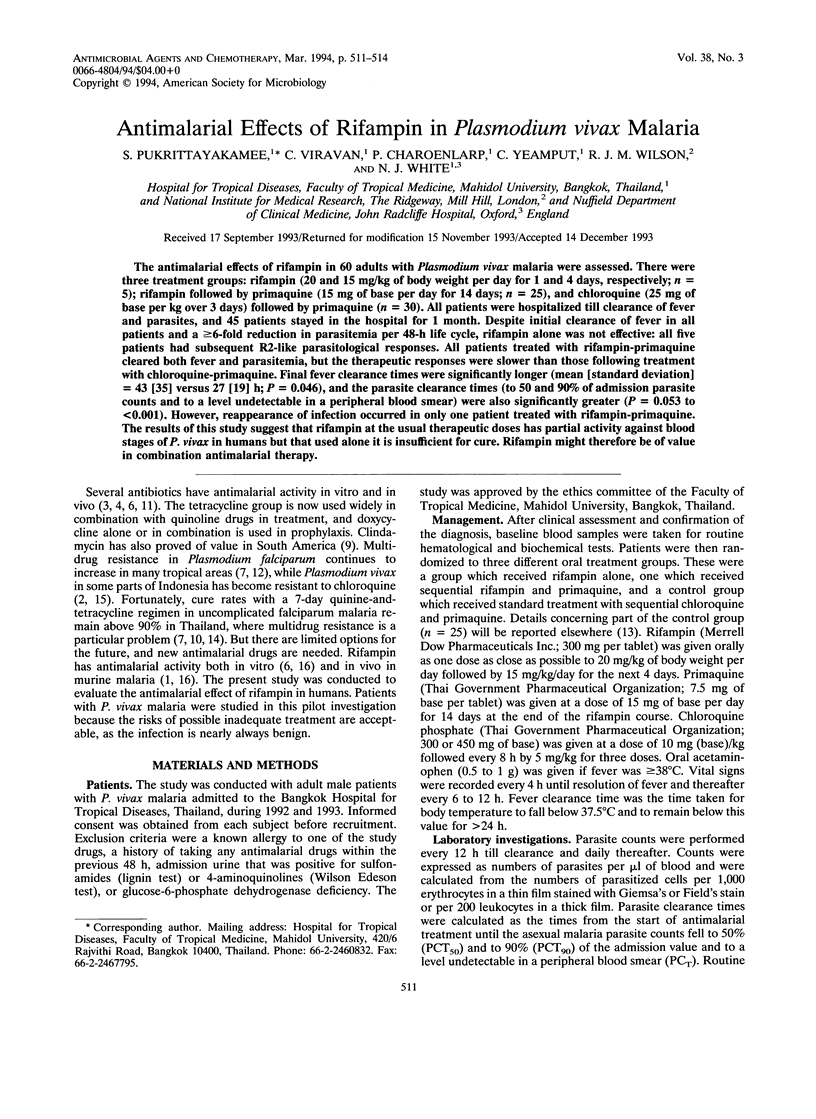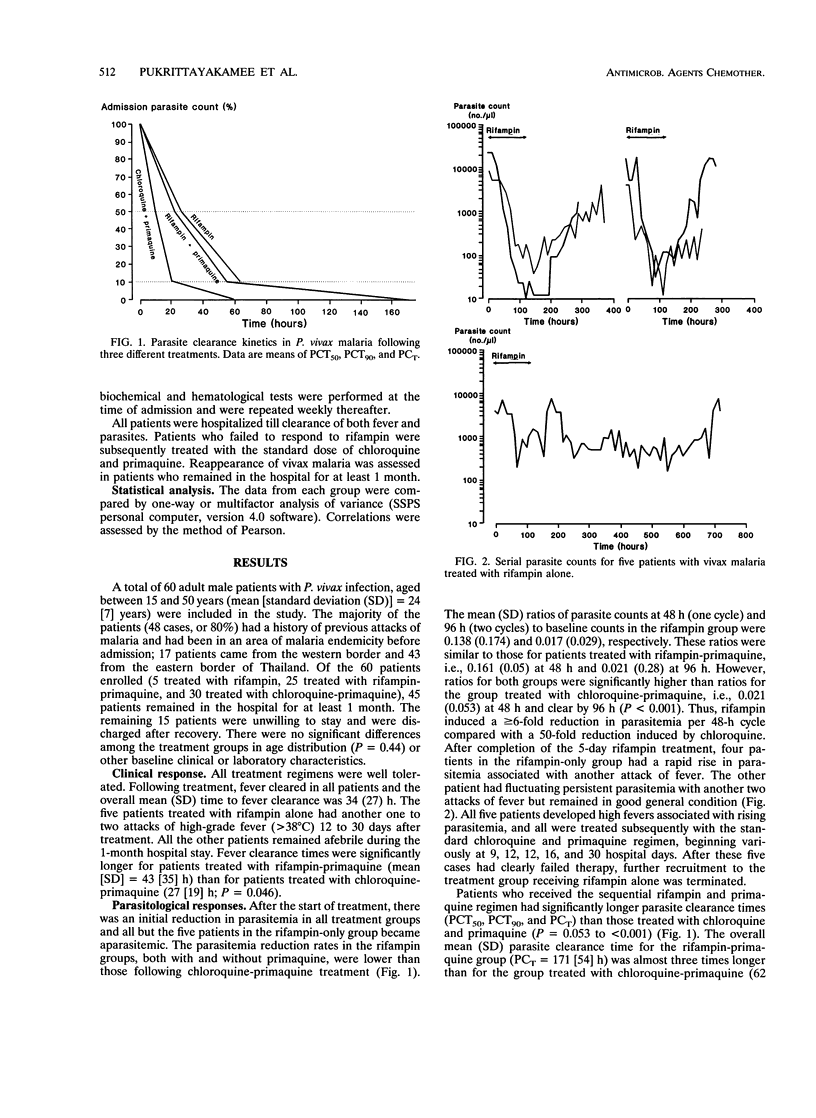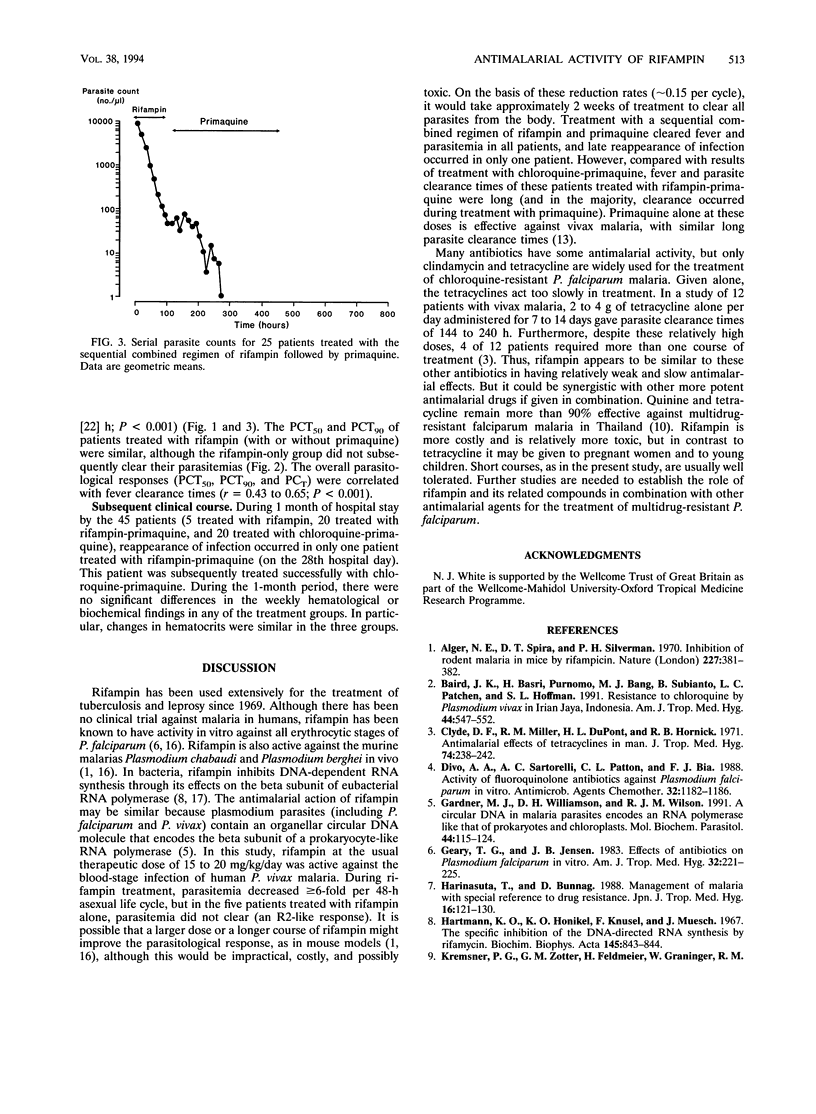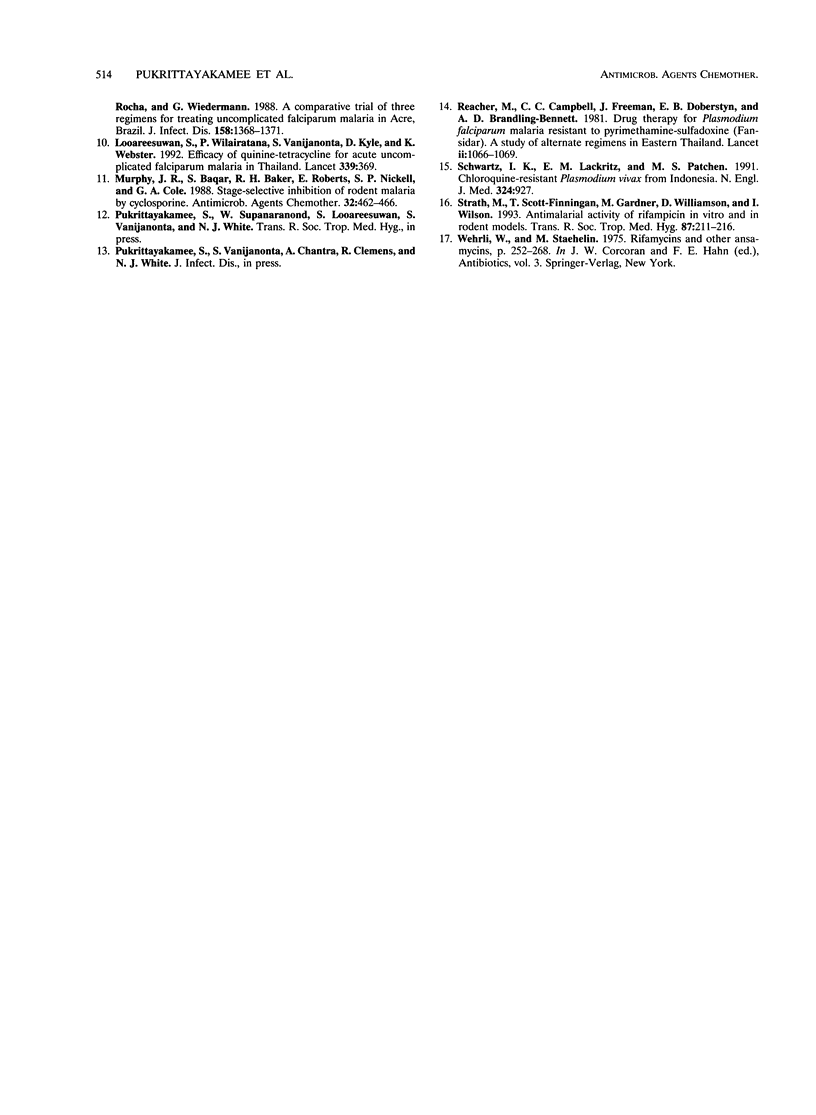Abstract
The antimalarial effects of rifampin in 60 adults with Plasmodium vivax malaria were assessed. There were three treatment groups: rifampin (20 and 15 mg/kg of body weight per day for 1 and 4 days, respectively; n = 5); rifampin followed by primaquine (15 mg of base per day for 14 days; n = 25), and chloroquine (25 mg of base per kg over 3 days) followed by primaquine (n = 30). All patients were hospitalized till clearance of fever and parasites, and 45 patients stayed in the hospital for 1 month. Despite initial clearance of fever in all patients and a > or = 6-fold reduction in parasitemia per 48-h life cycle, rifampin alone was not effective: all five patients had subsequent R2-like parasitological responses. All patients treated with rifampin-primaquine cleared both fever and parasitemia, but the therapeutic responses were slower than those following treatment with chloroquine-primaquine. Final fever clearance times were significantly longer (mean [standard deviation] = 43 [35] versus 27 [19] h; P = 0.046), and the parasite clearance times (to 50 and 90% of admission parasite counts and to a level undetectable in a peripheral blood smear) were also significantly greater (P = 0.053 to < 0.001). However, reappearance of infection occurred in only one patient treated with rifampin-primaquine. The results of this study suggest that rifampin at the usual therapeutic doses has partial activity against blood stages of P. vivax in humans but that used alone it is insufficient for cure. Rifampin might therefore be of value in combination antimalarial therapy.
Full text
PDF



Selected References
These references are in PubMed. This may not be the complete list of references from this article.
- Alger N. E., Spira D. T., Silverman P. H. Inhibition of rodent malaria in mice by rifampicin. Nature. 1970 Jul 25;227(5256):381–382. doi: 10.1038/227381b0. [DOI] [PubMed] [Google Scholar]
- Baird J. K., Basri H., Purnomo, Bangs M. J., Subianto B., Patchen L. C., Hoffman S. L. Resistance to chloroquine by Plasmodium vivax in Irian Jaya, Indonesia. Am J Trop Med Hyg. 1991 May;44(5):547–552. doi: 10.4269/ajtmh.1991.44.547. [DOI] [PubMed] [Google Scholar]
- Clyde D. F., Miller R. M., DuPont H. L., Hornick R. B. Antimalarial effects of tetracyclines in man. J Trop Med Hyg. 1971 Nov;74(11):238–242. [PubMed] [Google Scholar]
- Divo A. A., Sartorelli A. C., Patton C. L., Bia F. J. Activity of fluoroquinolone antibiotics against Plasmodium falciparum in vitro. Antimicrob Agents Chemother. 1988 Aug;32(8):1182–1186. doi: 10.1128/aac.32.8.1182. [DOI] [PMC free article] [PubMed] [Google Scholar]
- Gardner M. J., Williamson D. H., Wilson R. J. A circular DNA in malaria parasites encodes an RNA polymerase like that of prokaryotes and chloroplasts. Mol Biochem Parasitol. 1991 Jan;44(1):115–123. doi: 10.1016/0166-6851(91)90227-w. [DOI] [PubMed] [Google Scholar]
- Geary T. G., Jensen J. B. Effects of antibiotics on Plasmodium falciparum in vitro. Am J Trop Med Hyg. 1983 Mar;32(2):221–225. doi: 10.4269/ajtmh.1983.32.221. [DOI] [PubMed] [Google Scholar]
- Hartmann G., Honikel K. O., Knüsel F., Nüesch J. The specific inhibition of the DNA-directed RNA synthesis by rifamycin. Biochim Biophys Acta. 1967;145(3):843–844. doi: 10.1016/0005-2787(67)90147-5. [DOI] [PubMed] [Google Scholar]
- Kremsner P. G., Zotter G. M., Feldmeier H., Graninger W., Rocha R. M., Wiedermann G. A comparative trial of three regimens for treating uncomplicated falciparum malaria in Acre, Brazil. J Infect Dis. 1988 Dec;158(6):1368–1371. doi: 10.1093/infdis/158.6.1368. [DOI] [PubMed] [Google Scholar]
- Looareesuwan S., Wilairatana P., Vanijanonta S., Kyle D., Webster K. Efficacy of quinine-tetracycline for acute uncomplicated falciparum malaria in Thailand. Lancet. 1992 Feb 8;339(8789):369–369. doi: 10.1016/0140-6736(92)91690-a. [DOI] [PubMed] [Google Scholar]
- Murphy J. R., Baqar S., Baker R. H., Roberts E., Nickell S. P., Cole G. A. Stage-selective inhibition of rodent malaria by cyclosporine. Antimicrob Agents Chemother. 1988 Apr;32(4):462–466. doi: 10.1128/aac.32.4.462. [DOI] [PMC free article] [PubMed] [Google Scholar]
- Reacher M., Campbell C. C., Freeman J., Doberstyn E. B., Brandling-Bennett A. D. Drug therapy for Plasmodium falciparum malaria resistant to pyrimethamine-sulfadoxine (Fansidar). A study of alternate regimens in Eastern Thailand, 1980. Lancet. 1981 Nov 14;2(8255):1066–1069. doi: 10.1016/s0140-6736(81)91274-5. [DOI] [PubMed] [Google Scholar]
- Schwartz I. K., Lackritz E. M., Patchen L. C. Chloroquine-resistant Plasmodium vivax from Indonesia. N Engl J Med. 1991 Mar 28;324(13):927–927. doi: 10.1056/NEJM199103283241317. [DOI] [PubMed] [Google Scholar]
- Strath M., Scott-Finnigan T., Gardner M., Williamson D., Wilson I. Antimalarial activity of rifampicin in vitro and in rodent models. Trans R Soc Trop Med Hyg. 1993 Mar-Apr;87(2):211–216. doi: 10.1016/0035-9203(93)90497-e. [DOI] [PubMed] [Google Scholar]


